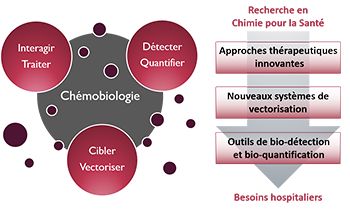- ⌂
-
Le DPM
Les Equipements
L'Environnement
Zoom sur... Le Bâtiment André Rassat
Nommé d'après une figure tutélaire de la chimie grenobloise, ce bâtiment est recouvert d’une double peau en feuille métallique qui apporte une protection thermique sur 3 côtés et crée une unité architecturale favorisant l'intégration parmi les arbres du site.
-
Thématiques
Le Thème
« Approches thérapeutiques innovantes »De nouvelles solutions thérapeutiques, de la cible biomacromolécu-laire émergente aux approches originales pour traiter les maladies
Le Thème
« Nouveaux systèmes de vectorisation »Combiner les propriétés d’inclusion de principes actifs, de franchisse-ment de barrières, d’adressage et de relar-gage en milieu vivant
Le Thème
« Outils de bio-détection et bio-quantification »Des dispositifs analytiques originaux pour la détection de cibles, de l’ion au micro-organisme en milieu complexe
Zoom sur... La Chémobiologie

-
Équipes
L'Équipe « COMET »
« COMET » développe la conception rationnelle, la synthèse et/ou l'extraction de composés à forte diversité/complexité comme nouveaux agents thérapeutiques et outils moléculaires pour la pénétration cellulaire ou la détection de biomolécules, actifs in vivo.L'Équipe « NOVA »
« NOVA » utilise des acides nucléiques fonctionnels comme éléments de reconnaissance pour des applications thérapeutiques ou diagnostiques, comme la sélection d'oligonucléotides, ou le développement de dispositifs d'analyses et de nanovecteurs.Les Services
-
Productions
Les Publications
La Vulgarisation
Les JSM
Zoom sur... La 12ème JSM (15 juin 2023)
Le DPM organise des journées scientifiques consacrées au médicament. L'objectif est de rassembler les spécialistes académiques et industriels autour d'une thématique. 2023 : Apports de la Chimie Click et de la Lumière en Chemobiologie
-
Partenariats
Les Formations
Les Consortiums
Les Financements
Zoom sur... L'environnement Grenoblois
Le DPM est un acteur central sur le bassin grenoblois en chimie, biologie et santé, lié au CHU Grenoble Alpes et à de nombreuses autres organisations : Pole de Recherche CBS, ICMG, Labex ARCANE, EUR CBH, Institut Carnot Polynat, Réseau GREEN.
Article
- Projet
- Farid OUKACINE,
- Titre
- Poly(glycidyl methacrylate)/silver nanocomposite microspheres as a radioiodine scavenger: Electrophoretic characterisation of carboxyl- and amine-modified particles
-
[Full paper
 ]
] - Auteurs
- H. Mackova, F. Oukacine, Z. Plichta, M. Hruby, J. Kucka, M. Taverna, D. Horak
- Edition
- J. Colloid Interface Sci. 2014, 421, 146-153.
- Année
- 2014
- Résumé
- Silver nanoparticles possess potent antibacterial properties and have extremely high affinities to radioiodine. For several applications, it is essential to anchor the nanoparticles to microparticles or solid surfaces to make them insoluble while retaining their unique properties. This current work is related to the design of anionic and cationic macroporous polymer microspheres based on poly(glycidyl methacrylate) (PGMA) obtained using a multistep swelling polymerisation. According to scanning electron microscopy, the microspheres were monodisperse in size and 4.21.mu m in diameter. The presence of the carboxyl and amino groups in the PGMA-COOH and PGMA-NH2 microspheres was confirmed by FT-IR spectroscopy. Capillary electrophoresis (CE) and pressure-assisted capillary electrophoresis (PACE) were used to study the electrophoretic behaviour of both types of microparticles. The electrophoretic mobility of the microparticles was changed into zeta potential using Smoluchowski modelling. Finally, silver-containing microspheres were prepared by reducing silver nitrate in the presence of the microspheres, and they proved effective for scavenging radioiodide ions from a model medium.




 Annuaire
Annuaire Contact
Contact Plan d'accès
Plan d'accès ENG
ENG Login
Login


